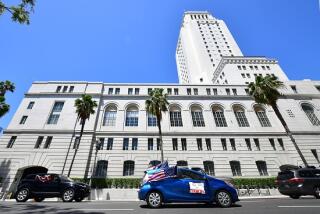Moreno Will Base Defense on Claim FBI Entrapped Him
- Share via
Santa Ana City Councilman Ted R. Moreno will fight political corruption charges by alleging he was entrapped by the FBI, his attorney disclosed for the first time Wednesday.
For two years, Moreno has strongly denied allegations that he extorted thousands of dollars from business owners with issues pending before the City Council. But according to interviews and court papers, Moreno plans to center his legal defense on whether the FBI crossed the line in its two-year corruption probe.
“This is a classic case of entrapment, and we look forward to presenting the facts at trial,” said Moreno’s lawyer, Dean Steward.
Moreno, 33, is scheduled to stand trial Monday in federal court on a 25-count indictment that includes charges of extortion, money laundering, mail fraud and providing false statements to the FBI.
Federal prosecutors contend Moreno masterminded a scheme to extort campaign contributions from business owners in 1996 in exchange for promises to support issues they had pending before the City Council. The FBI supplied one of the owners with money used to pay Moreno. Another businessman allegedly gave Moreno 14 1-ounce South African Krugerrands as a campaign contribution.
In order to prevail with an entrapment defense, Moreno will need to prove the FBI used gas station owner Victor Koshkerian to lure him into a crime he otherwise would not have committed.
Assistant U.S. Atty. John Hueston, who plans to present a videotape showing Moreno accepting cash payments, scoffed at the defense strategy.
“The evidence will show that there was no entrapment in this case,” Hueston said. “The evidence will show that Moreno was the willing ringleader in the charged deal-making and fraud against the citizens of Santa Ana in the 1996 election year.”
Hueston filed court documents Wednesday outlining the government’s case against Moreno. The documents include new allegations that Moreno tried to obstruct a federal investigation into the campaign contributions by instructing two witnesses not to testify to a federal grand jury.
Steward declined to provide details about his defense. But on Wednesday he gave U.S. District Judge Gary Taylor a list of questions he would like to ask prospective jurors, including their feelings about the entrapment issue.
Entrapment defenses are often used in such cases, especially those in which the prosecution has incriminating evidence such as a videotape, said Laurie Levenson, a Loyola Law School professor and former federal prosecutor.
“It’s fairly rare to win on entrapment,” Levenson said. “It’s not enough to show the government was sneaky. They have to show an innocent person was lured into committing a crime they otherwise were not predisposed to commit.”
In a highly publicized entrapment case, sports car maker John DeLorean was acquitted of cocaine trafficking charges in 1984 despite a videotape showing him sitting with undercover agents and a suitcase of cocaine.
Moreno, who under federal sentencing guidelines could be ordered to spend up to nine years in prison if convicted, is the last of four defendants in the case. Former Santa Ana Councilman Tony Espinoza and failed council candidates Roman Palacios and Hector Olivares have already pleaded guilty to federal charges.
According to a trial memo filed Wednesday, Moreno accepted $27,000 from Koshkerian in 1996 and used the money to fund his reelection effort and the campaigns of Palacios and Olivares. The memo also described an elaborate scheme to conceal the donations, including payment of cash to friends who in turn made political donations.
More to Read
Sign up for Essential California
The most important California stories and recommendations in your inbox every morning.
You may occasionally receive promotional content from the Los Angeles Times.














